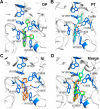Structural dissection reveals a general mechanistic principle for group II chitinase (ChtII) inhibition
- PMID: 31053640
- PMCID: PMC6579453
- DOI: 10.1074/jbc.RA119.007812
Structural dissection reveals a general mechanistic principle for group II chitinase (ChtII) inhibition
Abstract
Small-molecule inhibitors of insect chitinases have potential applications for controlling insect pests. Insect group II chitinase (ChtII) is the most important chitinase in insects and functions throughout all developmental stages. However, the possibility of inhibiting ChtII by small molecules has not been explored yet. Here, we report the structural characteristics of four molecules that exhibited similar levels of inhibitory activity against OfChtII, a group II chitinase from the agricultural pest Asian corn borer Ostrinia furnacalis These inhibitors were chitooctaose ((GlcN)8), dipyrido-pyrimidine derivative (DP), piperidine-thienopyridine derivative (PT), and naphthalimide derivative (NI). The crystal structures of the OfChtII catalytic domain complexed with each of the four inhibitors at 1.4-2.0 Å resolutions suggested they all exhibit similar binding modes within the substrate-binding cleft; specifically, two hydrophobic groups of the inhibitor interact with +1/+2 tryptophan and a -1 hydrophobic pocket. The structure of the (GlcN)8 complex surprisingly revealed that the oligosaccharide chain of the inhibitor is orientated in the opposite direction to that previously observed in complexes with other chitinases. Injection of the inhibitors into 4th instar O. furnacalis larvae led to defects in development and pupation. The results of this study provide insights into a general mechanistic principle that confers inhibitory activity against ChtII, which could facilitate rational design of agrochemicals that target ecdysis of insect pests.
Keywords: Asian corn borer (Ostrinia furnacalis); X-ray crystallography; ecdysis; glycoside hydrolase; group II chitinase; inhibition mechanism; inhibitor; inhibitor design; insect; protein crystallization.
© 2019 Chen et al.
Conflict of interest statement
The authors declare that they have no conflicts of interest with the contents of this article
Figures




Similar articles
-
Structural analysis of group II chitinase (ChtII) catalysis completes the puzzle of chitin hydrolysis in insects.J Biol Chem. 2018 Feb 23;293(8):2652-2660. doi: 10.1074/jbc.RA117.000119. Epub 2018 Jan 9. J Biol Chem. 2018. PMID: 29317504 Free PMC article.
-
Fully deacetylated chitooligosaccharides act as efficient glycoside hydrolase family 18 chitinase inhibitors.J Biol Chem. 2014 Jun 20;289(25):17932-40. doi: 10.1074/jbc.M114.564534. Epub 2014 May 14. J Biol Chem. 2014. PMID: 24828498 Free PMC article.
-
Insect group II chitinase OfChtII promotes chitin degradation during larva-pupa molting.Insect Sci. 2021 Jun;28(3):692-704. doi: 10.1111/1744-7917.12791. Epub 2020 Aug 13. Insect Sci. 2021. PMID: 32306549
-
Chitinolytic enzymes: catalysis, substrate binding, and their application.Curr Protein Pept Sci. 2000 Jul;1(1):105-24. doi: 10.2174/1389203003381450. Curr Protein Pept Sci. 2000. PMID: 12369923 Review.
-
Development of Novel Pesticides Targeting Insect Chitinases: A Minireview and Perspective.J Agric Food Chem. 2020 Apr 22;68(16):4559-4565. doi: 10.1021/acs.jafc.0c00888. Epub 2020 Apr 8. J Agric Food Chem. 2020. PMID: 32239934 Review.
Cited by
-
In Silico Studies of Lamiaceae Diterpenes with Bioinsecticide Potential against Aphis gossypii and Drosophila melanogaster.Molecules. 2021 Feb 2;26(3):766. doi: 10.3390/molecules26030766. Molecules. 2021. PMID: 33540716 Free PMC article.
-
Structure-based virtual screening of highly potent inhibitors of the nematode chitinase CeCht1.J Enzyme Inhib Med Chem. 2021 Dec;36(1):1198-1204. doi: 10.1080/14756366.2021.1931862. J Enzyme Inhib Med Chem. 2021. PMID: 34074203 Free PMC article.
-
Chitinase Gene Positively Regulates Hypersensitive and Defense Responses of Pepper to Colletotrichum acutatum Infection.Int J Mol Sci. 2020 Sep 10;21(18):6624. doi: 10.3390/ijms21186624. Int J Mol Sci. 2020. PMID: 32927746 Free PMC article.
-
Review on Structures of Pesticide Targets.Int J Mol Sci. 2020 Sep 28;21(19):7144. doi: 10.3390/ijms21197144. Int J Mol Sci. 2020. PMID: 32998191 Free PMC article. Review.
References
-
- Kramer K. J., and Koga D. (1986) Insect chitin: Physical state, synthesis, degradation and metabolic regulation. Insect Biochem. 16, 851–877 10.1016/0020-1790(86)90059-4 - DOI
Publication types
MeSH terms
Substances
Associated data
- Actions
- Actions
- Actions
- Actions
- Actions
- Actions
LinkOut - more resources
Full Text Sources

